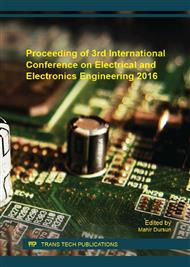[1]
D. E. Culler, http: /local. cs. berkeley. edu/webs.
Google Scholar
[2]
K. Pister, Centre for embedded network sensing, http: /research. cens. ucla. edu/. 3.
Google Scholar
[3]
Johnson, Michael, et al. A comparative review of wireless sensor network mote technologies., Sensors, 2009 IEEE. IEEE, (2009).
Google Scholar
[4]
Park, Chulsung, Jinfeng Liu, and Pai H. Chou. Eco: an ultra-compact low-power wireless sensor node for real-time motion monitoring., Information Processing in Sensor Networks, 2005. IPSN 2005. Fourth International Symposium on. IEEE, (2005).
DOI: 10.1109/ipsn.2005.1440956
Google Scholar
[5]
Akkas, Mustafa Alper, Ian F. Akyildiz, and Radosveta Sokullu. Terahertz channel modeling of underground sensor networks in oil reservoirs., Global Communications Conference (GLOBECOM), 2012 IEEE. IEEE, (2012).
DOI: 10.1109/glocom.2012.6503169
Google Scholar
[6]
Akyildiz, Ian F., and Josep Miquel Jornet. Electromagnetic wireless nanosensor networks., Nano Communication Networks 1. 1 (2010): 3-19.
DOI: 10.1016/j.nancom.2010.04.001
Google Scholar
[7]
Sun, Zhi, and Ian F. Akyildiz. Magnetic induction communications for wireless underground sensor networks., Antennas and Propagation, IEEE Transactions on 58. 7 (2010): 2426-2435.
DOI: 10.1109/tap.2010.2048858
Google Scholar
[8]
Pierobon, Massimiliano, and Ian F. Akyildiz. A physical end-to-end model for molecular communication in nanonetworks., Selected Areas in Communications, IEEE Journal on 28. 4 (2010): 602-611.
DOI: 10.1109/jsac.2010.100509
Google Scholar
[9]
Kedar, Debbie, and Shlomi Arnon. Urban optical wireless communication networks: the main challenges and possible solutions., Communications Magazine, IEEE 42. 5 (2004): S2-S7.
DOI: 10.1109/mcom.2004.1299334
Google Scholar
[10]
Climent S, Sanchez A, Capella JV, Meratnia N, and Serrano JJ. Underwater acoustic wireless sensor networks: advances and future trends in physical, MAC and routing layers., Sensors 14. 1 (2014): 795-833.
DOI: 10.3390/s140100795
Google Scholar
[11]
Gulbahar, Burhan, and Ozgur B. Akan. A communication theoretical modeling and analysis of underwater magneto-inductive wireless channels., Wireless Communications, IEEE Transactions on 11. 9 (2012): 3326-3334.
DOI: 10.1109/twc.2012.070912.111943
Google Scholar
[12]
Tadashi Nakano, Andrew W. Eckford, and Tokuko Haraguchi Cambridge University Press, 2013, ISBN 978-1-107-02308-6, hardcover, 179 pages.
Google Scholar
[13]
Oelze, Michael L., William D. O'Brien, and Robert G. Darmody. Measurement of attenuation and speed of sound in soils., Soil Science Society of America Journal 66. 3 (2002): 788-796.
DOI: 10.2136/sssaj2002.7880
Google Scholar
[14]
Garlington, Tom, Joel Babbitt, and George Long. Analysis of free space optics as a transmission technology., US Army Information Systems Engineering Command 3 (2005).
Google Scholar
[15]
Mizutani, Keiichi, Naoto Wakatsuki, and Koichi Mizutani. Acoustic communication in air using differential biphase shift keying with influence of impulse response and background noise., Japanese Journal of Applied Physics 46. 7S (2007): 4541.
DOI: 10.1143/jjap.46.4541
Google Scholar


